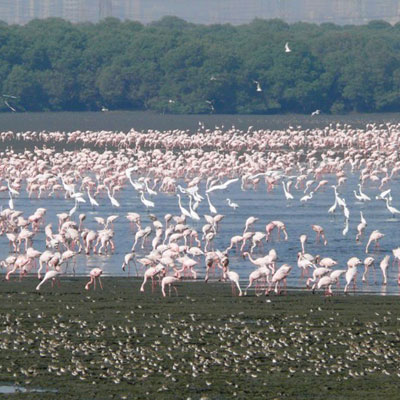Unsustainable developmental policies and rising insensitivity towards nature have put “in serious danger” at least 10 of the country’s famous bird habitats including Gujarat’s Flamingo City, a new study says.
Conservation society Bombay Natural History Society (BNHS) said that its recent findings clearly show that at least 10 Important Bird and Biodiversity Areas (IBAs) – as they are now called globally – are in serious danger of being lost forever.
BNHS studies and monitoring across the country have shown that the IBAs including Kutch’s famous Flamingo City, Great Indian Bustard Sanctuary in Solapur-Ahmednagar of Maharashtra and Sewri-Mahul Creek in Mumbai are among the most threatened habitats in the country. Flamingo City is possibly the only breeding ground of the migratory bird in a great magnitude in Asia.
The scattered grassland plots of the Great Indian Bustard Sanctuary are home to the critically endangered Great Indian Bustard. Their population at the sanctuary has plummeted from 27 birds in 2006 to 12 in 2012 and a mere three birds in 2013.
The other bird habitats which are in grave danger of losing tree cover include Sailana Kharmor Sanctuary in Ratlam, Madhya Pradesh; Tillangchong in Andaman-Nicobar; Dihaila Jheel and Karera Wildlife Sanctuary in Shivpuri, Madhya Pradesh; Basai in Gurgaon, Haryana; Sardarpur Florican Sanctuary in Dhar, Madhya Pradesh and Ranebennur in Haveri, Karnataka. “Many other IBAs, although not on this list, are also threatened by various types of unsustainable human interference,” says the new research titled “IBAs in Danger” by BNHS and its global partner BirdLife International.
According to it, destruction or disturbance due to infrastructure development, wrong anti-people conservation policies, indiscriminate livestock grazing, industrial and sewage pollution, indiscriminate agricultural expansion including use of pesticides, rapid urbanisation and poaching are some of the major reasons behind the loss of biodiversity and habitat in these and other areas.
“Unfortunately in India, nearly 50 per cent of the IBAs are not getting any sort of official recognition from the government agencies,” said Raju Kasambe, Project Manager of BNHS’ IBA Programme.
“Our future generations will never pardon us for destroying the important habitats of birds in such a callous manner,” he said.

